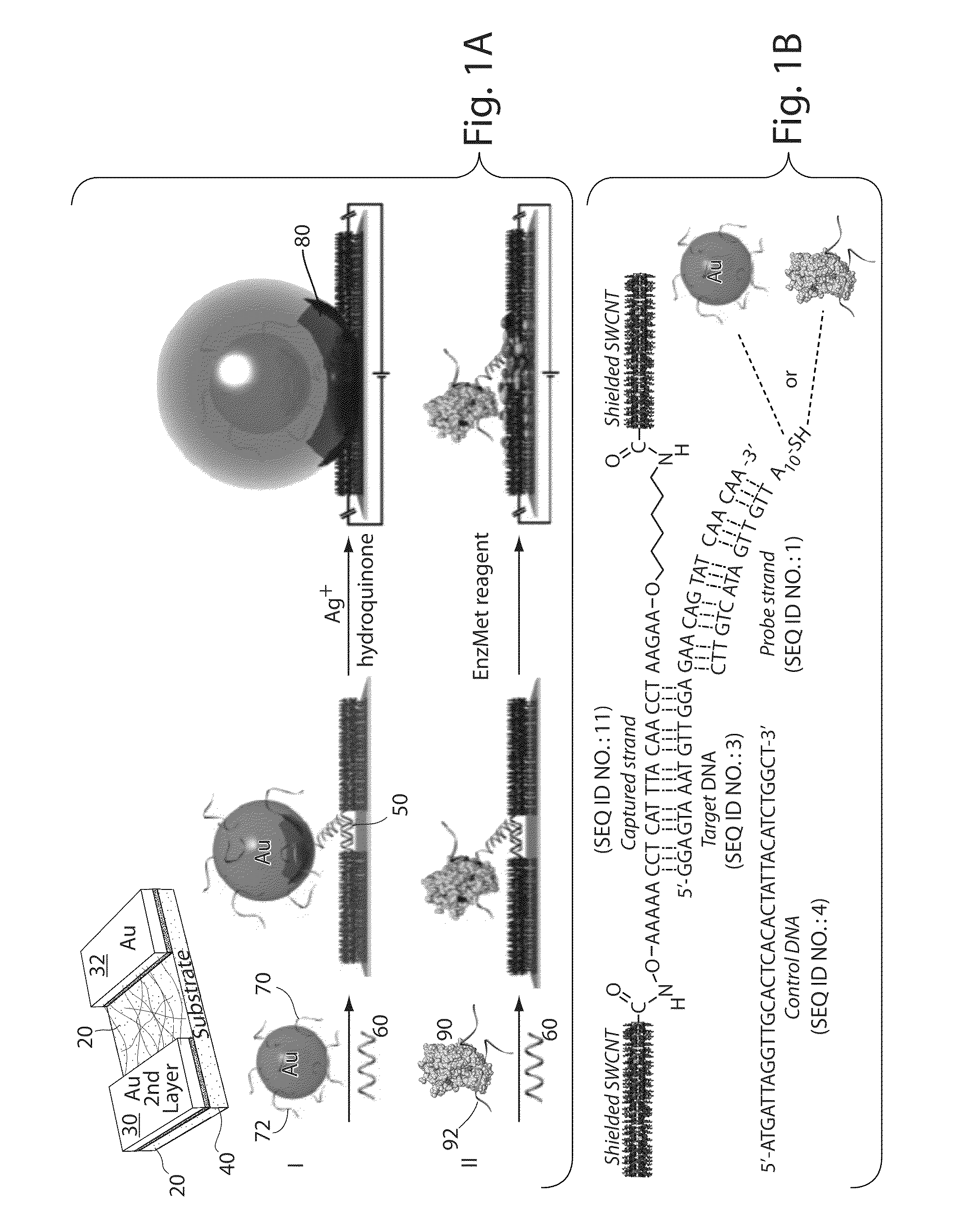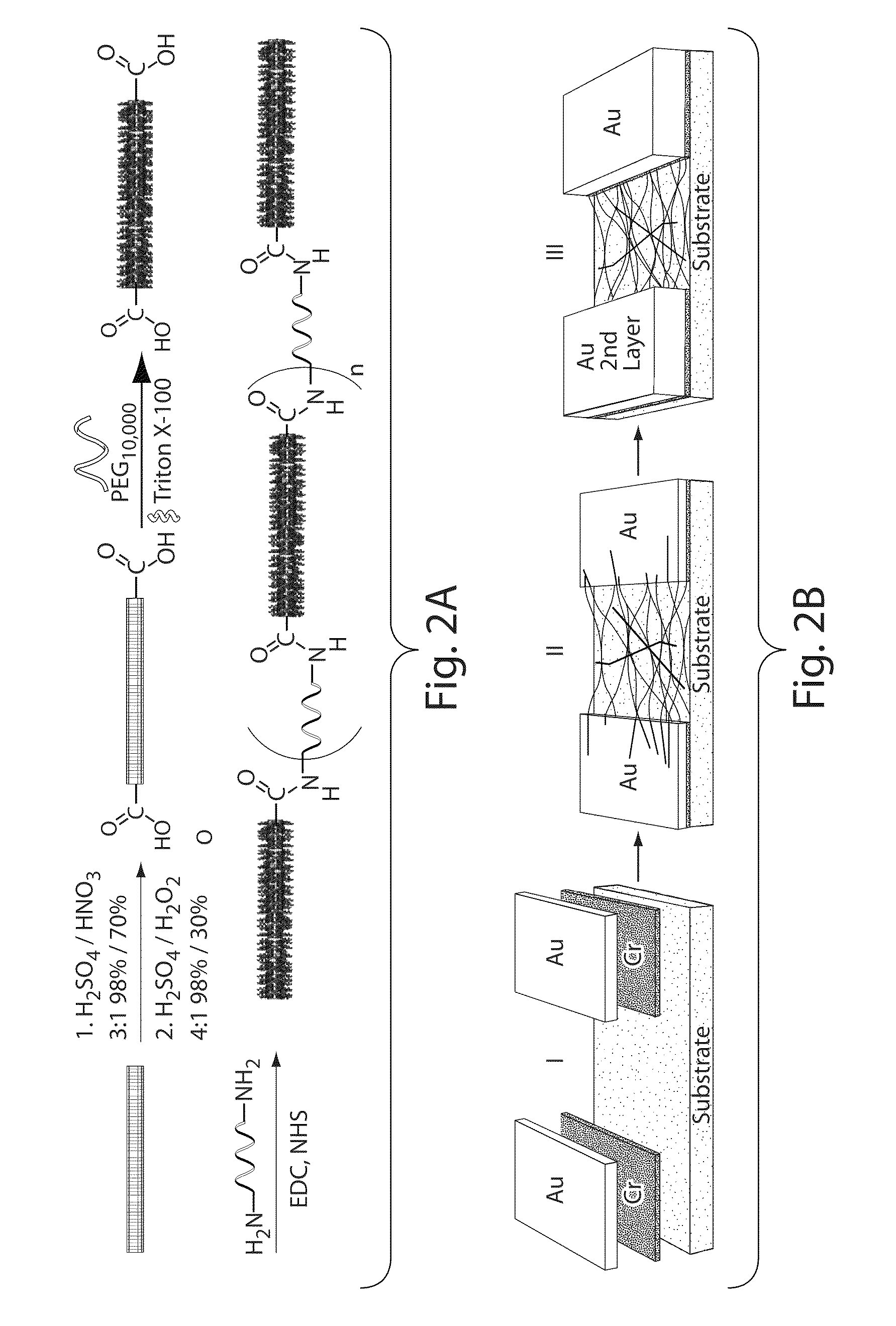Nanostructured devices including analyte detectors, and related methods
a technology of analyte detector and nanostructure, applied in the direction of instruments, biochemistry apparatus and processes, electrolysis components, etc., can solve the problem that amplified dna detection can be particularly difficul
- Summary
- Abstract
- Description
- Claims
- Application Information
AI Technical Summary
Problems solved by technology
Method used
Image
Examples
example 1
[0114]The following example describes the synthesis of a DNA-linked carbon nanotube wire. First, single-walled carbon nanotubes (SWCNTs) were cut and oxidized. Commercial HiPco SWCNTs were cut and etched according to a reported procedure (please see Liu et al., Science 1998, 280, 1253, which is incorporated herein by reference in its entirety for all purposes) to give shortened SWCNTs bearing carboxylic groups at their terminal ends (“SWCNT-COOH”) and also at defect sites on the sidewalls. Specifically, 50 mg of pristine pure HiPco SWCNTs were placed in a solution of 98% H2SO4 / 70% HNO3 (3:1, 24 mL) at 40° C. and sonicated at 42 kHz for 35 min. The solution was filtered using a 0.6 μm polycarbonate membrane filter and then etched for 30 minutes with a solution of 98% H2SO4 / 30% H2O2 (4:1, 20 mL) to remove all carbon particles produced by the first reaction. The resulting diluted nanotube-acid mixture was then filtered using a 0.6 μm polycarbonate membrane filter leaving a SWCNT filter...
example 2
[0117]The following example describes Au-nanoparticle functionalization with DNA. Au-nanoparticles (average diameter of 30 nm) were used at a concentration of ˜330 pM (˜2×10−11 particles mL−1). The disulfide bonds in all oligonucleotides (Probe DNAs) were reduced prior to mixing with the Au colloid by soaking in 0.1 M DTT with disulfide cleavage buffer for 2-3 h (5 nmol of lyophilized DNA was reduced with 100 μL of fresh 0.1 M DTT). The solutions of deprotected DNA were purified through desalting NAP-5 columns, and the amount of DNA from each column was determined by reading the absorbance of the solutions at 260 nm. A solution of the freshly deprotected DNA was then added to the Au colloid, 1 mL (final concentration of oligonucleotides 3-4 μM) to functionalize the Au nanoparticles, and the mixture was shaken gently overnight at room temperature. Phosphate buffer was added to the nanoparticle solution to obtain a final phosphate concentration of 9 mM, and a surfactant solution was a...
example 3
[0119]In the following example, horseradish peroxidase (HRP) was functionalized with DNA.
[0120]The crystal structure of HRP (PDB 1hch) was analyzed, rendered, and solvent accessible surface area calculations were performed using the UCSF Chimera software package (3). E. F. Pettersen, T. D. Goddard, C. C. Huang, G. S. Couch, et al., J Comput Chem 25, 1605-12 (2004). 1.75 nmol of HRP was reacted with 8.75 nmol of Sulfo-GMBS and 17.5 nmol thiolated DNA (Probe DNAs) in a ratio of 1:5:10, for 3 h at room temperature. The excess Sulfo-GMBS and DNA were removed using a Microcon centrifugal filter device unit (cut-off MW 30,000). Prior to modification, the disulfide bonds in all oligonucleotides were reduced by soaking in 0.1 M DTT in disulfide cleavage buffer for 2-3 h (100D of lyophilized DNA is typically reduced with 150 μL of freshly prepared solution of 0.1 M DTT). The deprotected DNA solutions were purified through desalting NAP-5 columns, and the amount of DNA from each column was de...
PUM
| Property | Measurement | Unit |
|---|---|---|
| Molar density | aaaaa | aaaaa |
| Molar density | aaaaa | aaaaa |
| Molar density | aaaaa | aaaaa |
Abstract
Description
Claims
Application Information
 Login to View More
Login to View More - R&D
- Intellectual Property
- Life Sciences
- Materials
- Tech Scout
- Unparalleled Data Quality
- Higher Quality Content
- 60% Fewer Hallucinations
Browse by: Latest US Patents, China's latest patents, Technical Efficacy Thesaurus, Application Domain, Technology Topic, Popular Technical Reports.
© 2025 PatSnap. All rights reserved.Legal|Privacy policy|Modern Slavery Act Transparency Statement|Sitemap|About US| Contact US: help@patsnap.com



